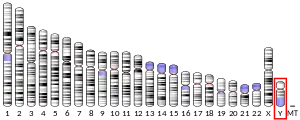DAZ3
Deleted in azoospermia protein 3 is a protein that in humans is encoded by the DAZ3 gene.[3][4]
| DAZ3 | |||||||||||||||||||||||||||||||||||||||||||||||||||
|---|---|---|---|---|---|---|---|---|---|---|---|---|---|---|---|---|---|---|---|---|---|---|---|---|---|---|---|---|---|---|---|---|---|---|---|---|---|---|---|---|---|---|---|---|---|---|---|---|---|---|---|
| Identifiers | |||||||||||||||||||||||||||||||||||||||||||||||||||
| Aliases | DAZ3, pDP1679, deleted in azoospermia 3 | ||||||||||||||||||||||||||||||||||||||||||||||||||
| External IDs | OMIM: 400027 HomoloGene: 133282 GeneCards: DAZ3 | ||||||||||||||||||||||||||||||||||||||||||||||||||
| |||||||||||||||||||||||||||||||||||||||||||||||||||
| |||||||||||||||||||||||||||||||||||||||||||||||||||
| |||||||||||||||||||||||||||||||||||||||||||||||||||
| |||||||||||||||||||||||||||||||||||||||||||||||||||
| Wikidata | |||||||||||||||||||||||||||||||||||||||||||||||||||
| |||||||||||||||||||||||||||||||||||||||||||||||||||
This gene is a member of the DAZ gene family and is a candidate for the human Y-chromosomal azoospermia factor (AZF). Its expression is restricted to premeiotic germ cells, particularly in spermatogonia. It encodes an RNA-binding protein that is important for spermatogenesis. Four copies of this gene are found on chromosome Y within palindromic duplications; one pair of genes is part of the P2 palindrome and the second pair is part of the P1 palindrome. Each gene contains a 2.4 kb repeat including a 72-bp exon, called the DAZ repeat; the number of DAZ repeats is variable and there are several variations in the sequence of the DAZ repeat. Each copy of the gene also contains a 10.8 kb region that may be amplified; this region includes five exons that encode an RNA recognition motif (RRM) domain. This gene contains one copy of the 10.8 kb repeat.[4]
References
- GRCh38: Ensembl release 89: ENSG00000187191 - Ensembl, May 2017
- "Human PubMed Reference:". National Center for Biotechnology Information, U.S. National Library of Medicine.
- Saxena R, de Vries JW, Repping S, Alagappan RK, Skaletsky H, Brown LG, Ma P, Chen E, Hoovers JM, Page DC (Sep 2000). "Four DAZ genes in two clusters found in the AZFc region of the human Y chromosome". Genomics. 67 (3): 256–67. doi:10.1006/geno.2000.6260. PMID 10936047.
- "Entrez Gene: DAZ3 deleted in azoospermia 3".
Further reading
- Foresta C, Ferlin A, Moro E, et al. (2002). "[Microdeletion of chromosome Y in male infertility: role of the DAZ gene]". Ann. Ital. Med. Int. 16 (2): 82–92. PMID 11688365.
- Fox MS, Reijo Pera RA (2002). "Male infertility, genetic analysis of the DAZ genes on the human Y chromosome and genetic analysis of DNA repair". Mol. Cell. Endocrinol. 184 (1–2): 41–9. doi:10.1016/S0303-7207(01)00646-3. PMID 11694340. S2CID 54277826.
- Vogt PH, Fernandes S (2003). "Polymorphic DAZ gene family in polymorphic structure of AZFc locus: Artwork or functional for human spermatogenesis?". APMIS. 111 (1): 115–26, discussion 126–7. doi:10.1034/j.1600-0463.2003.11101161.x. PMID 12752250. S2CID 41326783.
- Reijo R, Lee TY, Salo P, et al. (1995). "Diverse spermatogenic defects in humans caused by Y chromosome deletions encompassing a novel RNA-binding protein gene". Nat. Genet. 10 (4): 383–93. doi:10.1038/ng0895-383. PMID 7670487. S2CID 2917750.
- Reijo R, Seligman J, Dinulos MB, et al. (1996). "Mouse autosomal homolog of DAZ, a candidate male sterility gene in humans, is expressed in male germ cells before and after puberty". Genomics. 35 (2): 346–52. doi:10.1006/geno.1996.0366. PMID 8661148.
- Cooke HJ, Lee M, Kerr S, Ruggiu M (1996). "A murine homologue of the human DAZ gene is autosomal and expressed only in male and female gonads". Hum. Mol. Genet. 5 (4): 513–6. doi:10.1093/hmg/5.4.513. PMID 8845845.
- Saxena R, Brown LG, Hawkins T, et al. (1996). "The DAZ gene cluster on the human Y chromosome arose from an autosomal gene that was transposed, repeatedly amplified and pruned". Nat. Genet. 14 (3): 292–9. doi:10.1038/ng1196-292. PMID 8896558. S2CID 34964224.
- Yen PH, Chai NN, Salido EC (1997). "The human autosomal gene DAZLA: testis specificity and a candidate for male infertility". Hum. Mol. Genet. 5 (12): 2013–7. doi:10.1093/hmg/5.12.2013. PMID 8968756.
- Yen PH, Chai NN, Salido EC (1997). "The human DAZ genes, a putative male infertility factor on the Y chromosome, are highly polymorphic in the DAZ repeat regions". Mamm. Genome. 8 (10): 756–9. doi:10.1007/s003359900560. PMID 9321470. S2CID 33258251.
- Agulnik AI, Zharkikh A, Boettger-Tong H, et al. (1998). "Evolution of the DAZ gene family suggests that Y-linked DAZ plays little, or a limited, role in spermatogenesis but underlines a recent African origin for human populations". Hum. Mol. Genet. 7 (9): 1371–7. doi:10.1093/hmg/7.9.1371. PMID 9700189.
- Tsui S, Dai T, Roettger S, et al. (2000). "Identification of two novel proteins that interact with germ-cell-specific RNA-binding proteins DAZ and DAZL1". Genomics. 65 (3): 266–73. doi:10.1006/geno.2000.6169. PMID 10857750.
- Ruggiu M, Cooke HJ (2000). "In vivo and in vitro analysis of homodimerisation activity of the mouse Dazl1 protein". Gene. 252 (1–2): 119–26. doi:10.1016/S0378-1119(00)00219-5. PMID 10903443.
- Reijo RA, Dorfman DM, Slee R, et al. (2000). "DAZ family proteins exist throughout male germ cell development and transit from nucleus to cytoplasm at meiosis in humans and mice". Biol. Reprod. 63 (5): 1490–6. doi:10.1095/biolreprod63.5.1490. PMID 11058556.
- Moro E, Ferlin A, Yen PH, et al. (2000). "Male infertility caused by a de novo partial deletion of the DAZ cluster on the Y chromosome". J. Clin. Endocrinol. Metab. 85 (11): 4069–73. doi:10.1210/jcem.85.11.6929. PMID 11095434.
- Xu EY, Moore FL, Pera RA (2001). "A gene family required for human germ cell development evolved from an ancient meiotic gene conserved in metazoans". Proc. Natl. Acad. Sci. U.S.A. 98 (13): 7414–9. Bibcode:2001PNAS...98.7414Y. doi:10.1073/pnas.131090498. PMC 34683. PMID 11390979.
- Friel A, Houghton JA, Glennon M, et al. (2002). "A preliminary report on the implication of RT-PCR detection of DAZ, RBMY1, USP9Y and Protamine-2 mRNA in testicular biopsy samples from azoospermic men". Int. J. Androl. 25 (1): 59–64. doi:10.1046/j.1365-2605.2002.00326.x. PMID 11869379.
- Ferlin A, Moro E, Rossi A, Foresta C (2002). "A novel approach for the analysis of DAZ gene copy number in severely idiopathic infertile men". J. Endocrinol. Invest. 25 (1): RC1–3. doi:10.1007/bf03343952. PMID 11883873. S2CID 24737444.

